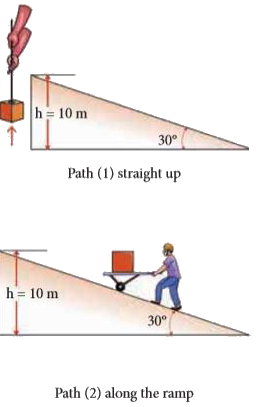A body of mass 100 kg is lifted to a height 10 m from the ground in two different ways as shown in the figure. What is the work done by the gravity in both the cases? Why is it easier to take the object through a ramp?

m = 100 kg, h = 10 m
Along path (1): The minimum force F1 required to move the object to the height of 10 m should be equal to the gravitational force,
F1=mg=100×10=1000N
The The distance moved along path (1) is, h = 10 m
The work done on the object along path (1) is
W=Fh=1000×10=10,000J
Along path (2):
In the case of ramp, the minimum force F2 that we apply on the object to take it up is not equal to mg, it is rather equal to mgsinθ.(mgsinθ<mg).
Here, angle θ=30∘
Therefore, F2=mgsinθ=100×10×sin30∘=100×10×0.5=500N
Hence,(mgsinθ<mg)
The path covered along the ramp is,
l=hsin30=100.5=20m
The work done on the object along path (2) is, W=F2l=500×20=10,000J
Since the gravitational force is a conservative force, the work done by gravity on the object is independent of the path taken.
In both the paths the work done by the gravitational force is 10,000 J
Along path (1): more face needs to be applied against gravity to cover lesser distance.
Along path (2): lesser force needs to be applied against the gravity to cover more distance.
As the force needs to be applied along the ramp is less, it is easier to move the object along the ramp.
Topper's Solved these Questions
- WORK, ENERGY AND POWERBOOK - NCERT TAMILCHAPTER - WORK, ENERGY AND POWEREXERCISE - EXERCISE - MULTIPLE CHOICE QUESTIONS
15 Videos
- WORK, ENERGY AND POWERBOOK - NCERT TAMILCHAPTER - WORK, ENERGY AND POWEREXERCISE - EXERCISE - IV. NUMERICAL PROBLEMS
5 Videos
- WORK, ENERGY AND POWERBOOK - NCERT TAMILCHAPTER - WORK, ENERGY AND POWEREXERCISE - EXERCISES (ADDITIONAL EXERCISES)
7 Videos
- WAVESBOOK - NCERT TAMILCHAPTER - WAVESEXERCISE - EVALUATION(IV. NUMERICAL PROBLEMS)
7 Videos
Similar Questions
Knowledge Check
A body of mass mkg lifted by a man to a height of one metre in 30sec . Another mass lifted the same mass to the same height in 60sec . The work done by then are them are in the ratio.
A1:2B1:1C2:1D4:1A body of mass 10 kg dropped from a height 20 m, acquires a velocity of 10m/s after a falling through a distance of 20m. What is the work done by the air resistance on the body?
A750 JB1000JC1500JD2000JA body of mass mkg lifted by a man to a height of one metre in 30sec . Another man lifted the same mass to the same height in 60sec . The work done by them are in the ratio.
A1:2B1:1C2:1D4:1
A body of mass mkg lifted by a man to a height of one metre in 30sec . Another mass lifted the same mass to the same height in 60sec . The work done by then are them are in the ratio.
View SolutionA body of mass mkg lifted by a man to a height of one metre in 30sec . Another mass lifted the same mass to the same height in 60sec . The work done by then are them are in the ratio.
View SolutionA block of mass 2kg is released from rest on a rough inclined ground as shown in figure. Find the work done on the block by.
 .
.
(Take g10m/s2).
View SolutionA block of mass 2kg is released from rest on a rough inclined ground as shown in figure. Find the work done on the block by a) gravity b) force of friction .when the block is displaced downward along the plane by 2m ?
 .
.
(Take g10m/s2).
View SolutionIf a body of mass 5 kg is lifted from the ground level to a height of 5m then ratio of its inertia is …………..
View Solution

